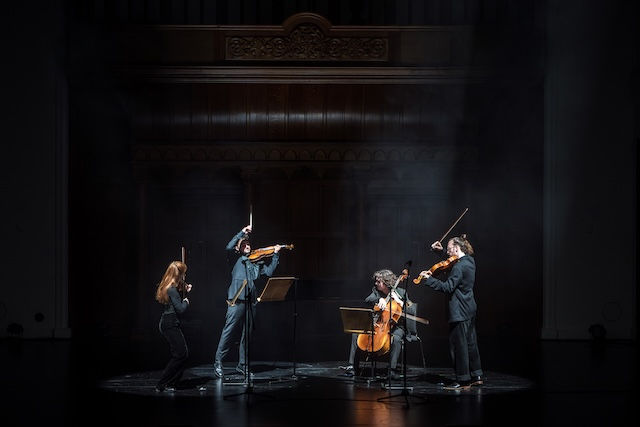Rediscovering a Visionary: Peter Darrell’s Five Rückert Songs at Ballet Nights.
- Olivia Godwin
- May 13
- 4 min read
Your insight into “Ich bin der Welt abhanden gekommen” a solo from Five Rückert Songs, choreographed by Peter Darrell CBE, being performed at Ballet Nights 008: Spring into Summer by Former Principal of Scottish Ballet, Eve Mutso; Soprano Hannah Dienes-Williams; and Ballet Nights House Concert Pianist, Viktor Erik Emanuel.

Above former Scottish Ballet Principal Eve Musto performing “Ich bin der Welt abhanden gekommen” at Ballet Nights 005: New Futures, photo by Deborah Jaffe.
Among the influential voices in new choreography in post-war Britain, Peter Darrell CBE emerged as a remarkable master of narrative in classical ballet. His talent for storytelling through movement was exceptional, and he often chose unconventional narratives, exploring complex human emotions and inner lives in ways that could only be expressed through dance. His ballets frequently pushed boundaries, revealing truths that were both surprising and thought-provoking.
Darrell’s work transformed perspectives on ballet, embedding layers of psychological depth and contemporary realism that drew in audiences beyond the art’s traditional reach. From his pioneering days with Western Theatre Ballet to establishing what would later become Scotland’s national ballet, The Scottish Ballet, Peter Darrell was a visionary and a creator of extraordinary influence.

Left: From the Archives the late Elaine McDonald as The Woman, photo by Alan Crumlish; Right: Former Scottish Ballet Principal Eve Musto as The Woman, photo by Kersti Kuuse.
Peter Darrell’s Five Rückert Songs, set to the haunting music of Gustav Mahler’s remarkable song cycle, traces the emotional arc of a figure simply called “The Woman.” “Ich bin der Welt abhanden gekommen,” translating to “I have become lost to the world,” is the final song of the piece and has become one of Darrell’s signature works, described by dance critic Geoffrey Baskerville as “a masterpiece.”
I have lost track of the world
With which I used to waste so much time;
It has heard nothing of me for so long,
It may well think I am dead.
And for me it is of no concern at all
If it treats me as dead.
Nor can I say anything at all against it,
For in truth I am dead to the world.
I am dead to the hurly-burly of the world
And take my rest in a place of quietness!
I live alone in my heaven,
In my loving, in my song.

Left: From the Archives the late Elaine McDonald as The Woman, photo by Alan Crumlish; Right: Former Scottish Ballet Principal Eve Musto as The Woman, photo by Kersti Kuuse.
Back in June 2023, we had the privilege of showcasing this work at Ballet Nights 005: New Futures, performed by former Scottish Ballet Principal Eve Musto, accompanied on stage by our Ballet Nights House Concert Pianist Viktor Erik Emanuel and mezzo-soprano student at the Royal Conservatoire of Scotland, Dana Mays.

Above former Scottish Ballet Principal Eve Musto and mezzo-soprano student at the Royal Conservatoire of Scotland, Dana Mays. performing “Ich bin der Welt abhanden gekommen” at Ballet Nights 005: New Futures, photo by Deborah Jaffe.
Astonishingly, this was the first time Peter Darrell's work had been seen in London since 1979, making the celebration of such a visionary pioneer of contemporary ballet even more special. That is why we are thrilled that this piece will return to Ballet Nights this June, at our new home venue, Cadogan Hall in Sloane Square.
The work of Peter Darrell, like so many other choreographers has been carefully recorded with the aid of Benesh Movement Notation, operating as an unseen language behind every precise movement on stage. A system of movement notation developed in the late 1940s by British ballet dancer Joan Benesh and her mathematician husband, Rudolf, BMN captures choreography through the careful positioning of abstract symbols plotted on a five-line stave, which correlates to the musical notation. Much like sheet music guides a pianist, Benesh notation allows the notator to record, read, and reconstruct dance with remarkable accuracy; ensuring that the artistry of dance can be preserved, taught, and restaged with integrity across generations.

From the tilt of a head to the sweep of an arm, every gesture can be mapped. The five lines of the stave represent key landmarks of the body—head, shoulders, waist, knees, and floor —while carefully plotted marks show position, direction, and dynamic quality. What you see here is an example of the Benesh Notation for Darrell’s Five Rückert Songs, the precise choreography of tonight’s performance written not in words but in the literacy of the body. Indeed Darrell, along with fellow choreographers such as Kenneth MacMillan, was an early adopter of the system, immediately grasping the value of notation in capturing and preserving his choreography and was instrumental in employing notators at Scottish Ballet.
The performance of 'Five Rückert Songs' at Ballet Nights 008: Spring into Summer is in celebration of the life of Eleanor Moore who sadly passed away in January of this year. Eleanor was the Scottish Ballet's first Scottish Principal dancer. During her 15 years with the company Eleanor danced many major roles including performing as the Woman in the premiere performance of 'Five Rückert Songs' in 1978 where she was partnered by her husband Paul Tyers. This was a ballet that she loved doing so it is fitting that we are celebrating her life here tonight with the Woman's final solo in Peter Darrell's 'Five Rückert Songs'.
To find out more, visit The Peter Darrell Trust, formed in 1994 to safeguard his creative legacy and to continue promoting his work and ideals.



Comments